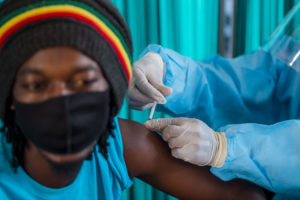The usual suspects have been out in force demanding greater health restrictions as the story of rising covid cases is peddled through the media. WHO Director-General Tedros Adhanom Ghebreyesus has been urging governments to employ “tried and tested measures” such as masking and testing, while various luminaries from the UK’s “Independent SAGE” are demanding a return to indoor masking and free lateral flow tests.
It’s certainly true that these measures have been “tried and tested”. Universal masking was tried from January 2020 in Hong Kong, seeing almost complete compliance outside the home; the world’s highest Covid fatality rate was recorded there in March of this year. South Korea was long hailed for its “successful test-and-trace system” that “beat the pandemic”; the strategy was abandoned in February because of record Omicron infections. Of course, both masking and test-and-trace have been tried in various combinations across high-income countries, including the UK — and yet in spite of this, the Office of National Statistics estimated in April that over 70% of Britons had been infected by Covid.
None of this is surprising: there never really was a scientific case for universal masking. This was obvious based on the pre-pandemic literature, which is why the WHO (alongside the CDC and high-profile public health experts such as Anthony Fauci) initially advised against mass masking; subsequent studies have confirmed that “existing data do not support universal, often improper, face mask use in the general population as a protective measure against Covid-19”. Even the New York Times has at least partially accepted this, running a piece on 31 May entitled “Why Masks Work, but Mandates Haven’t”. As for contact tracing, the pre-2020 consensus was even more trenchant, with the WHO’s 2019 report on “Non-pharmaceutical public health measures for mitigating the risk and impact of epidemic and pandemic influenza” claiming that “under no circumstances” should it be adopted, due to its limited effectiveness. (There is also no evidence that lockdowns had any enduring influence on the spread of Covid-19. In fact, they may have worsened it.)
At this point, it really isn’t clear what advocates of these “tried and failed” restrictions hope they will achieve, given that — even in conjunction with several doses of the Covid vaccines — they haven’t been able to prevent the vast majority of people contracting Covid. As Edinburgh University’s Professor of Epidemiology Mark Woolhouse wrote in The Year the World Went Mad, lockdowns and associated non-pharmaceutical interventions cannot eliminate a virus, or even prevent infections — they can only delay them, and even then just for a short while.
And yet, earlier this week, junior UK health minister Lord Kamall said restrictions could return if the NHS struggles to cope in the wake of increasing Covid cases. In Italy, meanwhile, the junior health minister Andrea Costa also failed to rule out the reintroduction of Covid restrictions in the face of rising cases, just saying that they would not return “for the moment”. We are seeing a resurgence of Covid fearmongering — which has done so much to inhibit a rational debate about the best ways to deal with the pandemic. The object of fear du jour is the latest Omicron subvariant, BA.5, which appears to be more contagious than any previous variant. If that’s the case, it simply means that non-pharmaceutical interventions would prove even more futile in containing its spread, meaning that reintroducing restrictions would be utterly illogical.
There’s also no evidence to claim, as a recent Daily Beast article asserted, that this new variant “is the most dangerous yet”. The most recent study (pre-print) concludes that “[d]isease severity was similar amongst diagnosed Covid-19 cases in the BA.4/BA.5 and BA.1 periods in the context of growing immunity against SARS-CoV-2 due to prior infection and vaccination, both of which were strongly protective”, while another one (under review) found that “[n]ewly emerged Omicron lineages BA.4/BA.5 continue to show reduced clinical severity compared to previous variants, as observed for Omicron BA.1”. Dr David Dowdy, an epidemiologist at the Johns Hopkins Bloomberg School of Public Health, told Business Insider: “Just as the virus is adapting, so too are our bodies.” He continued: “It’s not like with every variant things are getting worse. If anything, our bodies are getting smarter and we’re seeing fewer and fewer serious infections.”
Still, many argue that previous infection confers practically no immunity against BA.5 — and that, therefore, we should all be ready for another round of vaccination. In fact, the data shows no such thing; population-level data shows us unequivocally that prior infection confers immunity. The most recent study on the subject, published in the world-leading New England Journal of Medicine, shows that prior Covid infection conferred better protection against symptomatic Omicron (BA.1 and BA.2 subvariants) more than a year after infection than three doses of vaccine more than one month after the final dose.
However, the Covid fearmongers have another string to their bow. While the number of Covid deaths remains flat, there is increasing attention being given to “long Covid” (LC) as a debilitating condition that requires new restrictions, and yet another round of mass vaccination, in order to prevent more people from being afflicted by it. Should our leaders be listening?
The first question that has to be answered is: how serious a condition is LC? As with pretty much anything Covid-related, opinion is polarised — and, as so often, the truth is likely somewhere in the middle. While some studies have suggested that it occurs in as many as 30% of people infected with the virus, others have found the number to be 7% overall. One of the most in-depth studies yet, published in May 2022 in the Annals of Internal Medicine, was unable to find any biological explanation for LC symptoms. This, of course, doesn’t mean that LC is all in people’s head, as the researchers who conducted the study were keen to stress. (Indeed, we know people close to us who are suffering from it, so we can testify to the fact that it’s a serious issue.) The study does however suggest that LC might be a much more complex phenomenon than we imagine.
Indeed, the existence of LC in children and adolescents has been the subject of much debate due to the difficulty in ascertaining whether the most common symptoms usually associated with LC — sadness, tension, anger, depression, anxiety, fatigue, sleep disorders — are due to Covid itself or to other (co-)factors. One of the earliest cohort studies on LC, published in August 2021, concluded that:
“It is possible the symptoms associated with Long Covid are in fact a mixture of factors relating to the pandemic and lockdown as a whole rather than the viral infection itself. For example, factors such as social isolation, anxiety, depression or educational concerns may be the root cause of these symptoms in children and young people both with and without SARS-CoV-2 infection”.
Given the devastating and well-documented effects of lockdowns and school closures on the mental health of children, this doesn’t seem unreasonable.
A more recent study conducted by the Italian Society of Pediatrics found that “physical symptoms due to SARS-CoV-2, even if persisting after 4 weeks from infection, tend to regress spontaneously or under treatment in few months, whereas mental problems can persist for a longer time”. Given that “[s]everal factors indicate that mental health problems depend on the stress conditions children underwent during pandemic”, the researchers concluded that, “what has been reported for pediatric long Covid, further suggesting that most of the clinical manifestations characterising long Covid depend on the pandemic and not directly on the infection”.
One thing is clear: we still know too little about LC, which means we need to step up research into the condition — as sufferers have been demanding for a long time. But it would be unacceptable to weaponise the very real distress of those sufferers in order to justify new non-pharmaceutical interventions that have failed on all possible accounts, or a new round of coercive mass vaccination.
The received wisdom from the political-scientific establishment over the past year or so has been that universal vaccination will lead to herd immunity, and therefore to the end of infection (and, hence, of LC). However, given that the European Union has, to date, ordered 4.2 billion doses of Covid-19 vaccines, most of them from Pfizer — that’s almost 10 doses for every man, woman and child of all ages in the EU — it’s clear that even this establishment never thought that universal vaccination would lead to herd immunity (or at least not quickly). Now, though, even the political authorities (and other figures such as Bill Gates) acknowledge that the vaccines will not get rid of infections and don’t provide protection for long. A huge May 2022 study of more than 13 million people published in Nature Medicine has also found that “long Covid risk falls only slightly after vaccination”. Cases are rising, and there is pressure to “do something”. But if neither vaccines nor non-pharmaceutical interventions can’t prevent Covid infection, and if even some people who are not hospitalised develop LC symptoms, what is the solution?
Here, it’s worth returning to the first months of the pandemic, when there was no certainty that a Covid vaccine would ever be found. In those early months, treatments were considered by many to be every bit as hopeful a prospect as vaccines. You may remember the furore around Hydroxychloroquine, the anti-malarial which was quickly touted as “Trump’s cure” — but which Didier Raoult, one of France’s most cited scientists (and one of the 400 most-cited scientists in the world), also claimed to have used to great effect in the treatment of Covid symptoms early in the pandemic. You may also remember the controversies around Ivermectin.
These treatments were controversial, yes, but some scientists believed initially (and still believe) that effective treatments exist for early-stage Covid; surely, this is an avenue worth exploring? While enormous amounts of money have been spent on the Covid vaccines, much less has been invested in developing early-stage treatments — when treatments have been approved by regulators, such as Remdesivir, they tend to be late-stage courses.
Of course, vaccines are key in preventing serious illness and death in those at great risk from Covid — but this was always, in truth, a comparatively small section of the population, as study after study has shown. Now that it is clear that vaccines do not prevent infection, it’s time to shift the focus to the kind of early-stage treatments that are vital in preventing potential LC from developing. Insisting on the same restrictions and vaccine-centric strategy of the past few years and expecting a different result is, as Einstein might have said, simply insane.
Disclaimer
Some of the posts we share are controversial and we do not necessarily agree with them in the whole extend. Sometimes we agree with the content or part of it but we do not agree with the narration or language. Nevertheless we find them somehow interesting, valuable and/or informative or we share them, because we strongly believe in freedom of speech, free press and journalism. We strongly encourage you to have a critical approach to all the content, do your own research and analysis to build your own opinion.
We would be glad to have your feedback.
Source: UnHerd Read the original article here: https://unherd.com/




